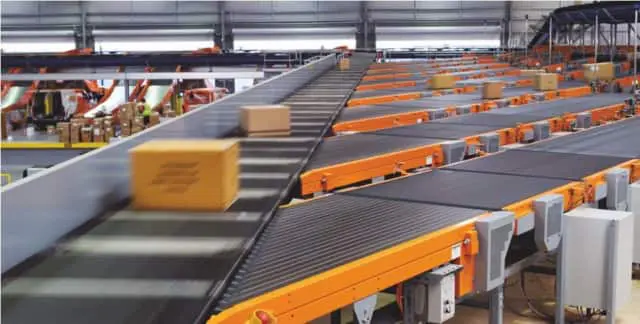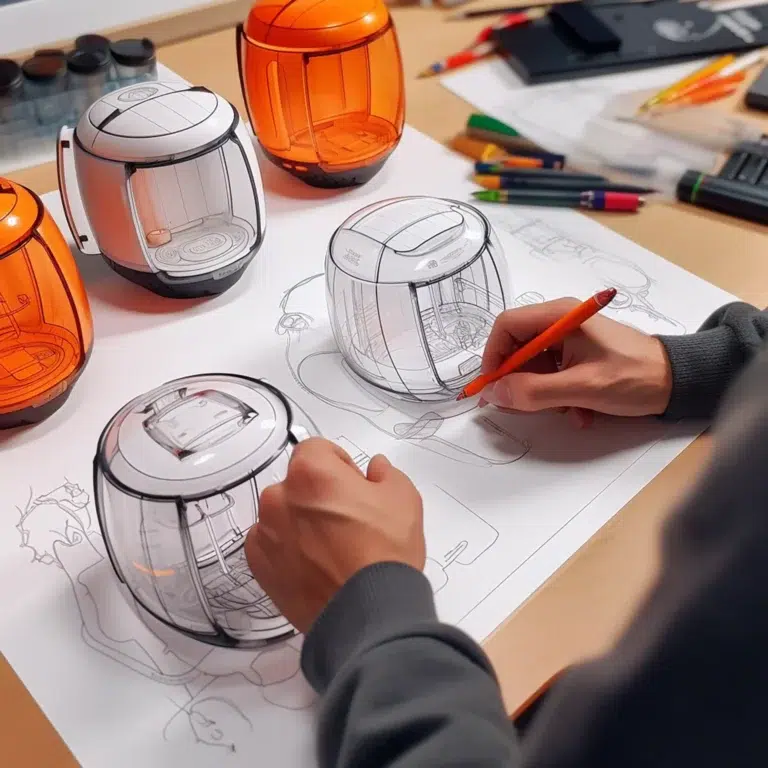All innovations need to start somewhere. You might have many good ideas. However, being innovative is about taking the next step and realizing those ideas.
What if you will get a check with money to start your project this afternoon? What are you going to do next? How can you realize your dream and what does it take to get there?
A few months ago, a corporate innovation project at Vanderlande won the RedDot Design Award with FLEET, a modular solution for airport logistics. Here’s the story of how that team went against the grain to bring innovation from sticky post to reality. We highlighted 9 essential skills for intrapreneurship unveiling what it takes to be an intrapreneur while working in a large organization.
9 insights from our corporate innovation journey.

Do you once in a while travel by plane? If the answer is yes, you might have already seen and used the products Vanderlande makes. They are the world leading producer of luggage conveyor belts for airports. Many people who travel by plane can rather be frustrated to think of luggage belts and all the inconvenience they are bringing in their lives – imagine how much time it takes to wait for your suitcase – but Vanderlande makes much money with it. Furthermore trending technology such as AI and robotics challenge today’s market and Vanderlande’s business model.
The Vanderlande innovation team drastically wanted to change their revenue idea from selling meters of conveyor belts to selling precious minutes instead. To actually do so they used self-driving vehicles to deliver the luggage. They used big data to control those self-driving vehicles and to speed up the process of sorting luggage.
They went through a similar journey you might now be going through. They pitched their idea, got investment and literally got a check with money to start their project that very afternoon. But then reality strikes… you get the check, move out of the building and realize you only have 6 months to deliver proof. What do you do?
The first and the most important step to any new project is taking a seat and figuring out what is possible to achieve in the first 6 months. A though business in the case of Vanderlande, as their CFO was already expecting sales in the first 6 months. But the ambitious team dealt with it in a proper way.
Might sound like an interesting story. But we don’t like to tell stories in a chronological way, so let’s just skip to the end and share what we’ve learned throughout this journey. This team, after all, perfectly illustrates that nothing is impossible. They were able to launch and actually implement their solution in only 6 months time.
Today we would love to share 9 simple but essential skills we learned when going through this journey together with the Vanderlande team.
Take-away #1
Learn how to start small: the art of minimum viable products.

What you need to be successful in a market launch is an MVP. But what is actually an MVP?
It’s a minimum viable product. Let’s keep it simple and explain it with a fun example.
The picture above portrays two very similar doughnuts. The only difference is, that the one on the left is actually fairly cheap and easy to make, and the one on the right is what everybody dreams of and it’s the one everybody wants to order in a bakery. What you want to go for in a journey of entrepreneurship is not to go for that fancy glazing doughnut on the right, but go for the minimum that you can make actually to fulfill the need(s) of your customers. The aim: to validate whether your hypotheses are correct or not. If people are hungry, you can test out very cheaply and easily a basic doughnut without all the extra fancy features you have in mind. So skip all those features and focus on the core of what you actually want to realize.
To come back to Vanderlande’s story where we were actually applying this in their internal startup. Basically, we didn’t focus on the technology straight away. What we actually wanted to validate in this journey was the willingness of our potential customers to pay for our solution.
We’re convinced to (in)validate this you should not immediately have the solution yourself. We made an animated video explaining the idea we had and all the challenges we were tackling with that specific solution. First of all, to set the stage, we explained we were working on a solution that is really transforming industries. A solution that is not made for next year, but for the next 20 years. And secondly, we identified the challenges our potential customers might face and further clarified the journey we were trying to develop. We realized all this, without spending any money on the technology itself. And it actually helped. After a few meetings, we put our video online and actually got quite some coverage. In a way, this video helped us to open some doors and get some first meetings.
Take-away #2
Form a great team: the hipster, the hacker, the hustler.
Innovation is made by people: regardless of what they’ll work on, a great team is a necessary condition to create relevant innovation. We identified 3 main characters that make the best teams: the hipster, the hacker and the hustler.
A hipster is a person with a vision, somebody who can think beyond what you are delivering today and that actually thrives on the idea of doing things differently. Of course, this person goes crazy and, every single week will be probably looking in a whole different direction.
Then the hacker comes in and says “I can help you out, I can make a small prototype for you, so you can actually focus on one thing instead of fifteen things at the same time”.
A hustler is a person that can sell your product. It’s a person who can take a product and bring it to customers and get things back flowing inside your company.
So take the time to grab a coffee with your small team and distribute who will be who for the next 6 months. Eventually, your team will grow but now it is just 3 of you: the hipster, the hacker and the hustler.
Take-away #3
Unplug from the organization.
Unplugging is a crucial element in the journey of an intrapreneur. In our eyes, unplugging is not about doing whatever you want: it’s rather about unplugging your innovation team from the core organization. Your core business is doing a really good job in leveraging an optimized productive status quo: bad side of that, it’s just “genetically” not fit for a change.
Unplugging can be really simple. In the case of Vanderlande, we just scanned for co-working spaces around the company and we knocked on the door of the closest co-working space, in this case, the High Tech Campus in Eindhoven, The Netherlands. A place full of smart people, technology and a real entrepreneurial spirit. We booked a room and spent there as much time as possible.
Take-away #4
Have. Fun.
Unplugging is a crucial element in the journey of an intrapreneur. In our eyes, unplugging is not about doing whatever you want: it’s rather about unplugging your innovation team from the core organization. Your core business is doing a really good job in leveraging an optimized productive status quo: bad side of that, it’s just “genetically” not fit for a change.
Unplugging can be really simple. In the case of Vanderlande, we just scanned for co-working spaces around the company and we knocked on the door of the closest co-working space, in this case, the High Tech Campus in Eindhoven, The Netherlands. A place full of smart people, technology and a real entrepreneurial spirit. We booked a room and spent there as much time as possible.
Take-away #5
Be bold and think beyond today.
Be brave.
For example, when you work in a company that is selling conveyor belts and you say you want to get rid of these conveyor belts it might get some negative feedback. That’s where courage really hits in.
Encourage each other by saying “they’re going to challenge everything we’ll propose, but by finding proofs we’ll show that we are on the right track”. Have that boldness to further move forward.
Take-away #6
Think big, act small, scale fast and stay humble.
But then again don’t only focus on being a hustler, focus on being humble as well.
What we mean with is that you don’t need to look at the big whales yet. Don’t look at the big contracts, don’t look at the big deals you can make. Instead, look at the small fishes and the small things you can manage to achieve with the team of 3-4 people. Don’t over promise, just go for the small deals because that’s where you learn how to get closer to the whales.
That’s what we did as well. We looked for the smallest airport in Europe which is in Lelystad, The Netherlands. It’s actually a really small private airport. They were interested in being a highly technological airport, and they were willing to take the jump with us. So we crafted the solution for them and they became our first customer.
We only sold 4 devices to the Lelystad Airport.
But luckily, our technique worked: soon after, the next customer was in line. Maastricht, part of the Schiphol Group, signed a deal a few months later. And after that, some of the largest airports in Europe and airlines in the USA were closing deals with us.
Be humble: focus on the small things first, scale later.
Take-away #7
You need a geek for great tech.
You’ll soon need a geek, someone that knows technology by heart.
In our case, we had a great plan but we needed a top-notch technology, we needed people that understand big data, automation and technology. We got them in, we partnered with them: if you can’t do it on your own, find someone else to support you. In 6 months time, we were able to put it in a booth and have a first airport actually running on our system.
Take-away #8
Smart business model.
Make sure to have a strong, smart business model in place. Watching this video may help you understand what we mean by that.
Going for a subscription model may sound like an easy decision, but it’s not that easy: abandoning a century-old basic business model takes some courage.
At Vanderlande we did the same: we mapped out all the stakeholders involved – airlines, airports, consumers, anyone that is involved in this journey – and looked at what we could bring as value while avoiding the traditional model of selling your product. How can you create, deliver and capture more value, through a smarter, non-obvious business model?
Take-away #9
Be empathic and keep the end user in mind.
The last takeaway we would love to share is about “being empathetic”, or as some others also might say “being customer-centric”.
At Vanderlande, when we started working out our solution, we spend our whole first month only talking to airlines and airports to really understand what they were looking for. We pivoted our solution quite a lot during our journey. Which is everything but a bad thing.
In the end, it was really nice to see that the journey that took us to a customer-centric solution was granted a design award that really focuses on customer centricity. Indeed, despite being a back-end system, the FLEET solution by Vanderlande since the very beginning aimed to improve people’s live: in this case, by reinventing luggage management solutions to deliver the luggage as soon as the passengers get out of the plane.


